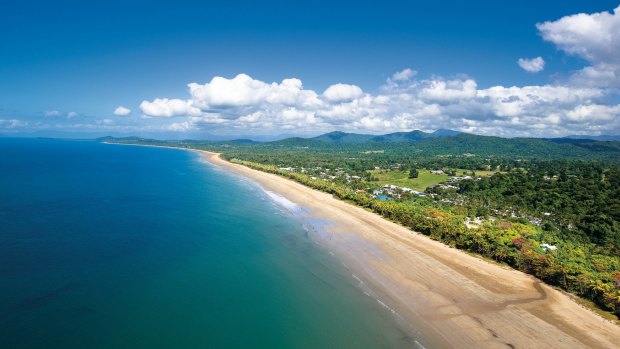This was published 4 years ago
Far North Queensland: The Cassowary Coast is proud of its deadly avian mascot
By Steve Meacham

Mission Beach.Credit: Vince Sofia
Wendy, the wonderfully cheerful greeter at Mission Beach tourist information centre, is demonstrating what I should do if I'm attacked by a male cassowary defending his young while on a rainforest walk in Djiru national park.
"Raise your arm like this," she says, like someone who has just won the meat tray at an RSL raffle. "And if you have a hat, wear it - and hoist it on a stick so the cassowary is intimidated by what he thinks is a bigger predator. Meanwhile back away….very slowly.
"And only when you get to a safe distance, whip your camera out to zoom in."
Mission Beach, which is roughly halfway between Cairns and Townsville, and about five kilometres east of Djiru, is the centre of Australia's Cassowary Coast.
Cassowary warning signs are everywhere. "Slow down! Cassowaries crossing." "Don't feed the cassowaries, they might die." There is a
Cassowary Drive, a Cassowary Shopping Centre and of course, Mission Beach falls within the recently renamed Cassowary Coast Regional council.
While other regions are doing their best to downplay the chance of tourists being killed, maimed or injured by - say - crocs, sharks, snakes, spiders and jellyfish, this part of Queensland has based its tourist profile on a flightless bird that is our closest living relative to a dinosaur and often referred to as "the world's most dangerous bird".
My visit is in June and Wonderful Wendy explains that it's a particularly delicate time to go searching for Queensland cassowaries.
The mums, having delivered between three and eight eggs in May, scarper, leaving the rest of the parenting up to the dads.
The males incubate the eggs in carefully-crafted mounds, raise the chicks and forage fiercely to feed the brood.
There are about 100 cassowaries - the third largest flightless bird in the world after the ostrich and the emu - in the Djiru national park, Wendy says before directing me to the Lacey Creek rainforest walk.
Have they really killed humans?
Yes, the first recorded death by cassowary in Australia was in 1926 when two McClean brothers - aged 16 and 13 - discovered one on their property and decided to club it to death. The cassowary kicked the younger brother with its lethal three-toed feet before turning on the older brother, who tripped. While he was on the ground, the cassowary trampled the teenager, severing his jugular vein.
The most recent recorded "death by cassowary" occurred in the US in the first half of 2019. Its 75-year-old Florida owner, who had raised the bird from a chick, was clawed to death after he fell to the ground.
So it is with some trepidation that I park my hire car and embark on the bush walk Wendy has recommended.
It's raining in the rainforest as I set off (without hat or stick).
By now I know the southern cassowary is the largest of three species (the other two are known as dwarf and northern cassowaries), found only in New Guinea and tropical north Queensland.
Southern cassowaries are shy birds, despite their significant size as adults. Males can reach 1.8 metres, while females are larger - up to two metres tall and can weigh 59 kilos.
I decide the best way to see a cassowary and live to tell the tale is to walk the Lacey Creek track as slowly and silently as possible, even if it means getting wet.
Along the way, I read the various signs indicating what else I might see: eel tail catfish, saw-shelled turtles, jungle perch, snakehead gudgeon. Sadly, I see none of them, nor a southern cassowary.
But I do spot other unusual things in Mission Beach, such as the sign on the main beach warning visitors they need to watch out since they will be sunbathing in a designated parachute-landing site.
Mission Beach - which is really four separate villages rather than a single destination - has managed to retain its laidback coastal character while becoming an adventure centre.
Apart from sky dives, there's white water rafting on the Tully river; scuba diving; snorkelling; horse riding; ferries to the Great Barrier Reef; and walks along the beach to beautiful rocky outcrops. And if you spot a cassowary? Count yourself lucky.
TRIP NOTES
Sign up for the Traveller Deals newsletter
Get exclusive travel deals delivered straight to your inbox. Sign up now.